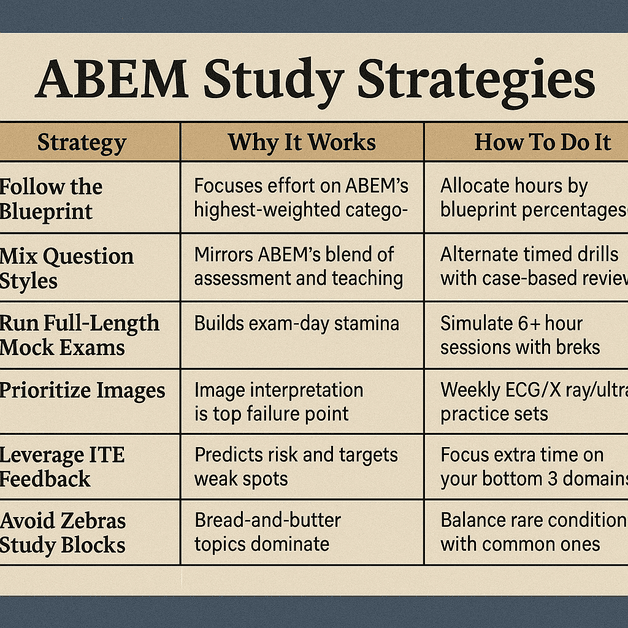How to Interpret Images on the ABEM Exam
ABEM image-based questions test rapid pattern recognition across CXR, ECG, and point‑of‑care ultrasound — focus on pattern recognition, key artifacts, and common mimics. Prioritize timed practice with labeled images and brief diagnostic anchors.
Why Images Matter on the ABEM Exam
The ABEM Qualifying Exam is ~305 multiple-choice, single-best-answer questions, administered in two timed sessions with a scheduled break. It can feel like a marathon.
You won’t just be reading text on screen — expect to be shown:
- ECGs
- chest films
- ultrasound clips
- CT scans
- even dermatology rashes
The boards are as visual as your ED shifts, where rapid interpretation of images drives diagnosis and management. Learn how to tackle ABEM image questions — from ECG prep to ultrasound test strategies. High-yield tips, pitfalls, and practice resources included.
👉 ABEM Pass Rates Explained: What the Numbers Really Mean
High-Yield Image Domains
The test blueprint comes straight from the 2022 EM Model. You can expect images to play a big part in the following sections:
- Cardiovascular Disorders (10%) – heavily ECG-based.
- Traumatic Disorders (9%) – FAST ultrasound, chest/pelvic radiographs.
- Thoracic/Respiratory Disorders (7%) – chest X-rays (pneumonia, effusion, pulmonary edema).
- Procedures & Skills (8%) – ultrasound-guided vascular access, procedural anatomy.
👉 ABEM Board Exam Guide 2025: How to Prepare and Pass
How Image Questions Appear
ABEM’s pictorial questions still follow the **single-best-answer** format. Common patterns include: pattern recognition, next-step decisions, and integration. All are multiple-choice, single-best-answer questions. So, you’ll get one question, one image, and four or five options — just like text-based questions.
Common Candidate Struggles
Most people trip up on the same things. Frequent weak spots are:
- ECG misreads (wide-complex tachycardia vs SVT with aberrancy, subtle ischemic changes).
- Ultrasound orientation/artifact pitfalls.
- Chest radiograph subtle findings (small pneumothorax, early edema, widened mediastinum).
- Dermatology recognition gaps (erythema multiforme vs Stevens-Johnson).
Training Strategies
- Study using the EM Model blueprint and ensure familiarity with both text and pictorial formats (ABEM – Qualifying Exam: https://www.abem.org/get-certified/qualifying-exam/).
- Dedicate one study block exclusively to images. Example: 30 minutes ECGs, 30 minutes radiographs, 15 minutes ultrasound clips
- Build a weekly “image lab.” Knock out some ECGs, flip through a few CXRs, then run a FAST clip or two. Short, regular practice beats one giant cram session.
- Train yourself to interpret an image quickly. On test day, you won’t have time to stare. Give yourself 20–30 seconds per image in practice so you can read fast and move on. This builds exam pacing.
- Record misinterpretations and distinguishing features. When you miss an image, jot down what you thought you saw and what it really was. Over time, you’ll spot patterns in your misses — and fix them
- Trust your first impression on classic findings. If your gut screams “STEMI” when you glance at the ECG, it probably is. Don’t talk yourself out of it.
- Apply systematic reads. Stick to a system every time: ABCDE on chest films, stepwise reads on ECGs. It keeps you from missing the obvious under pressure
👉 Preparing for the ABEM Exam: Study Strategies That Work
Example High-Yield Scenarios
- ECG: Wide-complex tachycardia with fusion beats → Ventricular tachycardia.
- CXR: Supine film with deep sulcus sign → Pneumothorax.
- FAST: Anechoic stripe in Morison’s pouch → Hemoperitoneum.
- Dermatology: Target lesions → Erythema multiforme.
Final Exam-Day Tips
- Trust first impressions.
- Use the stem context to guide interpretation.
- Don’t stall; mark and move.
- Apply systematic reads (ABCDE for CXR, stepwise ECG reads).
Bottom line: Key takeaways for ABEM image-based questions
ABEM confirms images are integral, and external EM societies (EMRA, SAEM, EMRAP) stress that systematic, regular image practice is one of the most reliable ways to improve performance.
FAQs About Image-Based Questions on the ABEM Exam
Q: Does the ABEM Qualifying Exam include image-based questions?
A: Absolutely. Expect ECGs, radiographs, ultrasounds, CTs, and dermatology images.
Q: How many image questions should I expect?
A: ABEM does not release exact numbers. However, based on the EM Model and exam feedback from test takers, ECGs and radiographs appear frequently, and ultrasound has expanded weight under “Procedures & Skills”.
Q: Are image questions harder than text-based ones?
A: They can be. Many people find ECGs and ultrasounds trip them up under pressure. If you don’t practice visuals, it’s one of the easiest ways to lose points.
Q: What resources are best for practicing ABEM image questions?
A: Not all study tools emphasize pictorial material equally. Here are the best options:
- Med-Challenger ABEM QBank – Fully mapped to the ABEM blueprint, includes extensive ECG, X-ray, and ultrasound questions, detailed explanations, and simulation modes.
- ABEM Sample Questions – Free official examples include pictorial formats: ABEM Qualifying Exam Content
- EMRA ECG Guide – Concise, high-yield ECG pearls with annotated images.
When choosing a QBank, ensure it includes robust pictorial coverage. Some banks underweight images, which can leave candidates underprepared.
👉 What is the Best Emergency Medicine Question Bank?
How can you prepare for the ABEM Exams? Med-Challenger Emergency Medicine Board Prep






